| | Introduction | Effects of wind erosion | Factors influencing wind erosion | Wind erosion control by crop and pasture management | Shelterbelts | Emergency control measures | Summary
Introduction
The Dust Bowl of the 1930s left vivid images in our minds of prairie skies blackened with blowing topsoil. But more powerful than images of blowing soil was the damage done - unproductive fields and ruined crops.
The Dust Bowl crisis prompted prairie agriculture to seek ways to control and prevent wind erosion. Much progress has been made since then. Many individuals have devoted countless hours to improving the management of prairie soils. Numerous improvements in farm machinery, crop varieties, fertilizers, herbicides and other crop inputs have helped farmers reduce wind erosion. Legislators have recognized the importance of preventing wind erosion. The Soil Conservation Act empowers each municipal soil conservation officer to work with landholders, either cooperatively or by issuing a legal notice, to stop or prevent erosion.
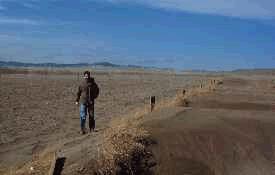
Wind erosion reduces the land's ability to produce crops.
Nevertheless, agricultural land across Alberta is still subject to periods of drought and strong winds. And farmers must still manage their cropping and grazing systems to reduce and prevent blowing soil. This publication describes ways to protect your soil from wind erosion.
Effects of Wind Erosion
Wind erosion damaged an estimated 900,000 hectares (two million acres) of agricultural soils in Alberta during the 1980s. Strong and sustained winds along with dry, bare soils contributed to serious soil loss.
Wind erosion is the detachment, transportation and redeposition of soil particles by wind. The most familiar result of wind erosion is the loss of topsoil and nutrients which reduces the soil's ability to produce crops. Topsoil loss can be seen as rocky or gravelly knolls, thin soils mixed with lighter coloured subsoil, or the presence of calcium carbonate in surface soils. Topsoil redeposition can be seen as raised fence lines, blackened snow drifts, sand deposits and ditches filled with soil.
Soil productivity is affected by wind erosion in various ways. Areas of erosion and deposition within a field increase the variation in soil characteristics, requiring more costly and less efficient soil management practices. Wind removes the smaller clay particles and organic matter from the soil while coarser materials are left behind.
The continued loss of fine particles reduces soil quality. In shallow soils and soils with a hardpan layer, wind erosion also results in decreased root zone depth and water-holding capacity. Such changes may occur slowly and go unnoticed for many years especially if mixing by tillage masks the effects of wind erosion.
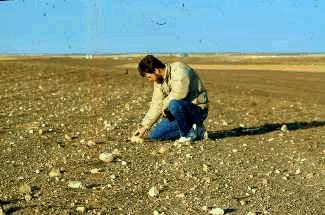
Wind removes smaller soil particles and leaves rocks exposed on the surface.
Factors Influencing Wind Erosion
A sparse or absent vegetative cover, a loose, dry and smooth soil surface, large fields and strong winds all increase the risk of wind erosion.
Vegetation protects soil from wind erosion by reducing the wind speed at the soil surface. The vegetative cover can be a growing crop, standing stubble or other crop residues. Most soils require a 30 per cent ground cover to prevent wind erosion. In the case of cereal crop residues, this is equivalent to about 900 to 1100 kg/ha (800 to 1000 lbs/ac) of residue. Highly erodible soils could require double this amount of residue.
Soil texture and structure also affect wind erosion risk. Loams, clay loams and silt loams are generally more resistant to aggregate breakdown, and thus are more resistant to wind erosion. Soil structure is the combination of individual soil particles into aggregates. Aggregates are heavier than individual particles and so are harder for wind to move. Organic matter helps to hold aggregates together and so soils with more organic matter are more resistant to wind erosion. Sandy soils are very susceptible to erosion. Clay soils which have been pulverized by frequent freezing and thawing are also very erodible.
Wind Erosion Control by Crop and Pasture Management
The most common crop production systems in Alberta are: rotations that include summerfallow; continuous cropping; irrigated cropping; and forage production. Wind erosion is a threat to soils in all four cropping systems and in pastures. You can reduce wind erosion and maintain production by maintaining a protective plant cover for the soil.
Protecting summerfallow fields
Tilling summerfallow fields dries out the surface soil and leaves it prone to erosion. Bare fields are especially at risk of wind erosion in late winter and spring at the end of the fallow period, and immediately after seeding of the next crop.
The best way to conserve soil moisture and prevent wind erosion is to leave as much crop residue cover as possible during the fallow period. The crop residue cover reduces evaporation, and standing stubble traps snow for extra spring soil moisture. At the same time, crop residues reduce wind speed at the soil surface, and standing stubble anchors the soil.
To maintain a crop residue cover, some farmers choose to use chemfallow, eliminating tillage and relying entirely on herbicides. Others replace one or more tillage operations on fallow with a herbicide application. For example, you can control winter annual weeds by using 2,4-D in late fall or early spring. This allows you to delay the first cultivation during fallow until late May or early June. Also, rotary harrows can control weeds without disturbing the residue cover if they are set for minimal activity.
If you decide to till, keep the tillage speed at 8 km/hour (5 miles/hour) or less. When cultivating, use wide blades or low crown sweeps that maintain the residue cover. To leave more standing stubble, remove the mounted harrows from the cultivator. Avoid cultivating summerfallow after late August. The remaining standing weeds will not draw too much more moisture from the soil, yet they will help trap snow and reduce wind erosion during winter. Avoid tilling eroded knolls; just lift your implement up when you pass over the knolls.
Finally, try to avoid summerfallowing on canola stubble. It breaks down easily and so provides only limited protection from erosion and limited moisture conservation benefits.
Effect of tillage equipment on crop residue cover
Implement | % of residue cover
remaining after one pass |
| moldboard plow | 10 |
| chisel plow (less than 12-inch) | 50 to 70 |
| sweeps (20-inch to 30-inch) | 80 |
| blade (more than 30-inch) | 90 |
| offset disc | 50 |
| tandem disc | 60 |
| harrow-springtooth | 65 |
| harrow-steel tooth (more than 12-inch) | 95 |
Protecting continuously cropped fields
Wind erosion in continuous cropping systems usually results from tillage practices that have buried most or all of the residues from the previous crop. Reducing or eliminating tillage will maintain a residue cover for erosion control with the added benefit of soil moisture conservation. If you decide to till, use a low tillage speed, use implements that bury less residue, and avoid tilling eroded knolls.
Reduced or zero tillage systems must include crop residue management. Residue management starts at harvest. Use the combine to evenly spread chopped straw and chaff over the entire width of the cut. Uniform spreading helps to reduce problems such as plugging in seeding equipment and uneven crop emergence.
After harvest, you may need to use oscillating harrows to spread clumps of straw. A rotary or flail mower can be used in the spring to chop very heavy residues or very tall standing stubble. Avoid burning an unharvested crop or heavy, poorly spread straw. Burning destroys soil humus and organic carbon, and leaves soil prone to erosion.
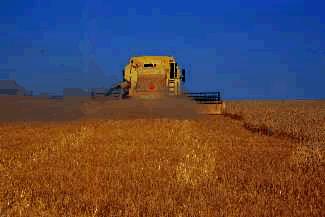
In reduced and zero tillage systems, crop residues must be spread evenly.
For direct seeding systems, use high clearance planters. Seeding into anchored stubble is often not as difficult as seeding through stubble loosened by cultivation. Ground opener types range from ones that barely disturb the soil to others that disturb the soil enough to provide some weed control during seeding.
Protecting irrigated fields
On irrigated fields, residue management often involves burial of the heavy crop residues produced by high-yielding crops (e.g. soft wheat). This can leave these fields very susceptible to wind erosion.
As with the other crop production systems, the best way to control wind erosion on irrigated land is to maintain a crop residue cover by reducing or eliminating tillage. If possible, chop and evenly spread crop residues using the combine. Be sure that the combine's chopping and spreading equipment does its job well enough for the seeder to clear the residues in the spring. You can also manage very heavy residues by mowing them with a flail or rotary mower. Baling and removing heavy residues is another option as long as sufficient residues remain to protect the soil from erosion.
Irrigated crops such as sugar beets, potatoes and beans leave little residue cover. Special measures are needed to prevent wind erosion on these fields. For crops that are harvested early, seed a cover crop of oats or rye. The cover crop is able to grow sufficiently before winter to protect the soil but will not present a residue problem in the following spring.
Non-irrigated corners of pivot-irrigation fields tend to be focal points for wind erosion. Planting forages or grass on these corners will protect them from wind erosion.
Protecting forage fields
Forage fields can also be damaged by wind erosion. The greatest risk is when the fields are broken up with heavy disks and plows to convert them to annual crop production for weed control and stand rejuvenation. Direct seeding of forages, cereals and oilseeds into forage stands is the best way to reduce the erosion risk from forage conversion.
Crops can be direct seeded into a forage stand after the stand has been killed with a herbicide. Fall spraying, usually with glyphosate, provides good suppression of forage plants. Research shows equal or better yields compared to using tillage.
Protecting pastures
Overgrazing reduces long-term pasture productivity and leaves soil prone to erosion. Grazing must be managed to leave adequated plant cover. In general, for perennial pastures under continuous grazing, leave about 50 per cent of the current growth for native range and about 25 percent for tame pastures.
Shelterbelts
Field shelterbelts can provide extra protection against wind erosion no matter what cropping system is used. They are especially important in dry years when low crop yields result in insufficient residue cover.
Field shelterbelts reduce the wind velocity for distances up to 30 times the height of the trees. They also trap snow, increasing soil moisture for increased crop yields. This yield increase helps to offset yield losses associated with taking land out of crop production for the shelterbelt plantings.
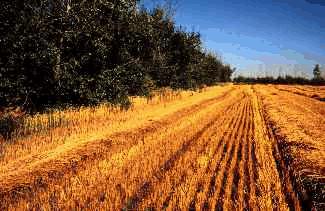
Field shelterbelts reduce wind erosion and conserve soil moisture.
To get the maximum benefit from your shelterbelts, you will need to plan the design and species selection, site preparation, weed control for the first years, and pruning and other maintenance. You will need to select a species suitable to your area. New options for shelterbelt weed control - such as plastic, fabric or bark mulches - have reduced the effort needed to establish shelterbelts.
Emergency Control Measures
Wind erosion may still occur even if preventive measures are taken. Dry soil, poor snow cover, poor residue cover from low-yielding crops, and persistent strong winds make controlling erosion a formidable challenge. It takes only one serious wind erosion event in 20 years to negate all the careful management of the intervening years. Emergency controls are used when wind erosion is imminent or has started. Increasing the surface roughness of a field or covering the soil with straw or manure are the two basic emergency measures.
Increasing surface roughness
A rougher surface reduces wind speed at the soil surface so the wind is less able to move soil particles.
Ripping clay soils: Ripping clay soil using spikes will usually bring up non-erodible clods to create a rough surface. If the clods are likely to break down quickly, then the distance between passes should be about 5 m (15 feet). This way, the procedure can be repeated later on the untreated strip if necessary.
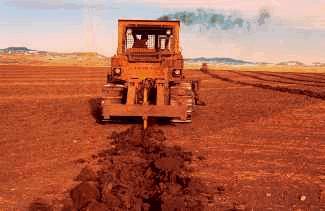
Ripping is an emergency measure to reduce wind ersosion on clay soil.
Listing sandy soils: Listing is used for sandy soils because they do not produce durable clods. Listing ridges the soil and brings up firmer subsoil. It must be perpendicular to the eroding wind, and should always start on the upwind side of the field. Treating the entire field will greatly reduce erodibility. Lister shovels are only mounted on the back gang of a heavy duty cultivator. Lister shovels (either 33 or 38 cm (13 or 15 in.)) are commonly used in irrigated potato production in southern Alberta. Properly listed, the flat surface of a field can be changed so that ridges are 25 to 30 cm (10 to 12 in.) higher than the troughs, and about 90 cm (36 in.) apart. For listing to be successful, the shovels must be able to penetrate to a depth of 15 to 20 cm (6 to 8 in.).
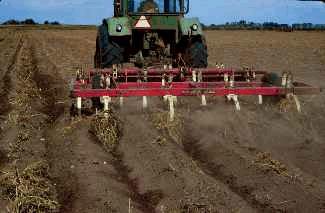
Listing of sandy soil reduces wind erosion.
When ripping or listing, tillage speed should not exceed 6.4 km/hour (4 miles/hour). Increasing the surface roughness should be done before the soil freezes. Even frozen soil can erode; it can blow away a layer at a time if just the top few millimetres are thawed and dry.
Covering soil with manure or straw
Manure is preferred as a soil cover because it also enhances soil fertility and tilth. Depending on the soil, a rate of 30 to 60 tonnes/ha (15 to 30 tons/ac) is required to protect the soil. Spread the manure evenly, and do not work it into the ground.
Spreading straw at 2 to 4 tonnes/ha (1 to 2 tons/ac) also protects eroding soil. The straw should be shredded, not used in small bales. It may have to be hairpinned with a disk implement to anchor it against the wind. Apply the straw before freeze-up because anchoring straw into the ground is very difficult once the soil is frozen.
Summary
Wind erosion has plagued prairie agriculture for many decades. However, with today's farming equipment and practices, wind erosion control can easily be a part of your crop and pasture management systems. To control wind erosion:
- maintain a vegetative cover, either growing plants or crop residues,
- reduce cultivated fallow,
- reduce or eliminate tillage,
- if you do till, choose a tillage implement that buries less residue and reduce tillage speed,
- plant and maintain field shelterbelts.
- avoid overgrazing
These measures also benefit crop and pasture production system by conserving soil moisture for better yields.
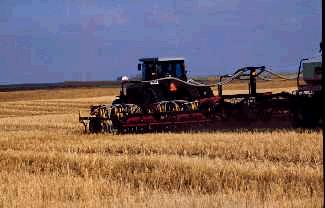
Modern equipment allows seeding into standing stubble.
Modern harvesting and residue handling equipment allows farmers to manage crop residues effectively. Under most conditions, a good crop residue cover can be maintained without hampering subsequent equipment operations or crop growth. Today's selection of planting equipment offers excellent residue clearance, depth control and packing so you can plant crops through standing stubble and spread residues.
However, drought and persistent strong winds can still cause wind erosion even if preventive measures are used. Use emergency controls if wind erosion is imminent or in its early stages. Emergency controls include ripping the soil to bring up clods, listing to change the shape of the soil surface, and covering the soil with manure or straw.
Wind erosion is a serious problem which threatens the long-term productivity of prairie soils. By using appropriate conservation farming techniques, you can reduce wind erosion under most conditions. The soil is a precious resource which needs your protection.
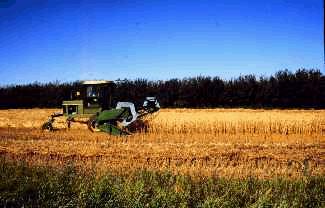
Control wind erosion with a crop residue cover and shelterbelts.
More information
Contact your local Alberta Agriculture, Food and Rural Development or Agriculture and Agri-Food Canada office for more information and other publications on wind erosion control direct seeding, shelterbelts residue management and grazing management.
Information provided by the late John Timmermans and Frank Larney.
For more information contact Dale Chrapko.
Source: Agdex 572-2. |
|